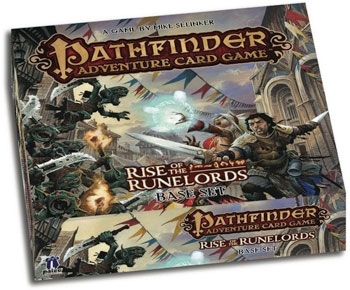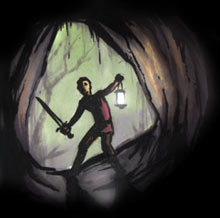by Demian Katz

Pathfinder Adventure Card Game:
Rise of the Runelords
Published by Paizo Publishing (2013)
Designed by Mike Selinker
Illustrated by Todd Remick
Contents: 495 cards (including 110 cards in the Burnt Offerings Adventure Deck), set of 5 polyhedral dice, 24 page rulebook, storage tray
1-4 players
90 minutes
$59.95 (base set)/$19.95 (Character/Adventure decks)
One of my favorite parts of role-playing is the cooperative, collaborative nature of the game. Thus, as Iíve had less and less time in my life for actual role-playing, Iíve been very pleased by the rise of cooperative board and card games, which capture that same experience in a less time-consuming form. However, there are some other elements of role-playing – notably character progression and storytelling – which are generally missing from non-RPG co-ops. Fortunately, the Pathfinder Adventure Card Game has come along to bring even more of the role-playing experience to the table in convenient, bite-sized chunks.
Gameplay
Like any good traditional hack-and-slash RPG, the Pathfinder Adventure Card Game is all about picking out characters with unique sets of abilities and then rolling fistfuls of dice to use those abilities. Each player has a character sheet listing abilities and attributes plus a custom-built deck representing equipment, allies, spells and ďblessingsĒ (which boost die rolls). Most of the gameplay involves drawing a card representing either a foe/obstacle to defeat or an item/ally to gain, calculating the odds of a particular character overcoming the challenge, playing cards to adjust the difficulty, and rolling lots of dice to determine success or failure. Often, failure will result in discarding cards from hands or even permanently losing items from decks. Discarding is no small thing, since running out of cards in a character's deck results in death.
The structure that motivates all this dice-rolling and card-play is pretty simple. Every game is set up according to a card which lists the locations, primary villain and henchmen that make up the present scenario. Each location card specifies the particular mix of cards that make up the deck at that location. Location decks are built, villains and henchmen are randomly distributed between the location decks, and players choose their starting locations. The object of the game is for the players to find and defeat the villain – which requires moving from location to location and burning through decks while racing against the ticking clock of a ďblessings deckĒ that generally limits the game to thirty turns. Of course, donít think itís just a matter of finding and defeating the villain – defeated villains will run to another location unless their path is blocked, so players need to spread out strategically and find ways of closing locations (generally by emptying decks or defeating henchmen in combination with meeting location-specific requirements) to close the net.
This is all very well, but what really makes the game compelling is the fact that it takes advantage of the Pathfinder brandís ďAdventure PathĒ concept. If the scenario cards were simply random, one would likely lose interest fairly quickly. However, scenarios are structured into adventures, and adventures are structured into adventure paths. Upon completing each scenario, players advance their characters, either by activating new abilities on their character sheets or by drawing additional cards to work into their decks. Completing all of the scenarios of an adventure or all of the adventures of an adventure path confer additional benefits. Completing an adventure also opens up new possibilities, as each adventure requires the players to shuffle a new set of cards into all of the gameís decks.
Strengths and Weaknesses
It could be argued that the ďAdventure PathĒ structure of the game is simultaneously the gameís biggest strength and its biggest weakness. Itís a strength because it makes the game compelling and addictive and reproduces much of the joy of leveling up in an RPG and setting off for points unknown in a new adventure. Itís a weakness because it means the game is fairly limited in and of itself, and to keep getting your new fixes of adventure, you have to buy deck after deck from Paizo. I personally have found this investment to be worthwhile so far, as the constant change and growth of the deck really keeps things unpredictable, and itís always a pleasure to see which special rules make each new scenario unique. However, it is a fair argument that the base game on its own doesnít give you nearly as much value for money as the average non-progression-oriented cooperative game, which generally sacrifices richness of theme for greater replayability.
It is also worth noting that there is an upper limit to character progression in the game. While it seems that Paizo is committed to releasing new adventure paths as long as people are willing to buy them, the current plan appears to involve starting over with new characters on each adventure path (though the possibility of higher-level adventures has at least been hinted at). I donít view this as a problem – Iíll happily accept a thirty-odd-scenario campaign as a pretty good extended gaming experience – but some players have expressed disappointment that they canít just carry on their original PCs forever.
To my mind, beyond whatís already been stated, the biggest flaw in the game (though certainly not a fatal one) is that it doesnít tell a compelling story. While every adventure path, adventure, and scenario includes some flavor text, thereís not enough to construct a real narrative, and what story can be gathered is of a generic fantasy flavor that might be intended to be tongue-in-cheek but generally comes off as merely bland. Obviously, I donít honestly expect my card games to tell me wonderful stories, but a tighter narrative with meaningful twists and turns would have added one more element of a good RPG that I have still not found in a co-op board or card game (though I hear rumors that Mice & Mystics has something to offer in this space).
Conclusions
What probably speaks louder than anything I could actually say about this game is the fact that I have played nothing else since I purchased it. My gaming group enjoys it, and its fairly predictable one-hour duration makes it possible for us to fit some adventures into otherwise very busy schedules.
I will readily admit that this is the sort of game whose novelty may eventually wear off – if the cost of buying new decks ever exceeds the amount of fun I derive from playing the game, I will inevitably stop playing. However, for the moment, this is by far the best RPG stand-in I have come across (dethroning Castle Ravenloft as my go-to fantasy game), and I eagerly await each new session. If you have more gaming time than I do, you might find yourself burning through all of the scenarios and spending restless weeks awaiting the release of the next deck. If, like me, your game time is limited, youíll find the enjoyment of the game can keep you happily occupied for many months. Either way, if you like the flavor of RPGs but need a game thatís slightly simpler, much faster, and more accessible to non-role-players, the Pathfinder Adventure Card Game is well worth a look.
Links:
| Related reviews on OgreCave: |
|
|



